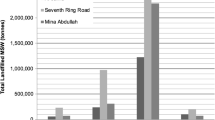Abstract
The leachate levels in the landfills in southern China are generally high. Field monitoring was carried out in the Suzhou landfill to investigate the leachate mound. The saturated hydraulic conductivity and soil–water characteristic curve (SWCC) of municipal solid waste were measured using samples taken from different depths of the landfill. Field monitoring reveals that a perched leachate mound and a substantial main leachate mound existed in the landfill. The saturated hydraulic conductivities of wastes in shallow, middle and deep depth were measured to be 4.81 × 10−2, 3.50 × 10−3 and 3.56 × 10−4 cm/s, respectively. The results of SWCC tests show that the SWCC curve was steep when matric suction was low, and the shallower the waste the steeper would be the curve. In addition to the field and laboratory tests, an unsaturated–saturated seepage analysis was conducted to simulate the development of the high leachate mound and to calculate the annual leachate production. The simulated volumetric water content in the unsaturated zone was about 40 %, which agreed well with the test result. The calculated leachate mound was consistent with the field measurement. The calculated annual and daily leachate productions were all more reasonable than the results of the HELP model.







Similar content being viewed by others
References
Brooks RH, Corey AT (1964) Hydraulic properties of porous media. Fort Collins, Colorado
Campbell GS (1974) A simple method for determining unsaturated hydraulic conductivity from moisture retention data. Soil Sci 117:311–314
Chen TH, Chynoweth DP (1995) Hydraulic conductivity of compacted municipal solid waste. Bioresour Technol 51:205–212
ECPS-PRC (Editorial Committee of Professional Standards of People’s Republic of China) (2004) Regulations on sanitary landfill of municipal solid waste (CJJ17-2004). China Architecture and Building Press, Beijing (in Chinese)
Field CR, Nangunoori RK (1993) Case study—efficacy of the HELP model: a myth or reality. In: Proceedings HELP model workshop for landfill design and evaluation, Tampa
Jang YS (2000) Analysis of flow behavior in a landfill with cover soil of low hydraulic conductivity. Environ Geol 39:292–298
Jang YS, Kim YW, Lee SI (2002) Hydraulic properties and leachate table analysis of Kimpo metropolitan landfill, Korea. Waste Manage 22:261–267
Korfiatis GP, Demetracopoulos AC, Bourodimos EL et al (1984) Moisture transport in a solid waste column. J Environ Eng 110:789–796
Oweis IS, Smith DA, Ellwood RB, Greene DS (1990) Hydraulic characteristics of municipal refuse. J Geotech Eng 116:539–553
Peyton RL, Schroder PR (1988) Field verification of HELP model for landfills. J Environ Eng 114:247–269
Qian XD, Koerner RM, Gray DH (2002) Geotechnical aspects of landfill design and construction. Prentice-Hall, Inc., New Jersey
Schroeder PR, Dozier TS, Zappi PA et al (1994) The hydrologic evaluation of landfill performance (HELP) model: engineering documentation for version 3. EPA/600/E-94/168b. US Environmental Protection Agency Office of Research and Development, Washington, DC
Townsend TG, Wise WR, Jain P (2005) One-dimensional gas flow model for horizontal gas collection systems at municipal solid waste landfills. J Environ Eng 131:1716–1723
USEPA (1985) Minimum technology guidance on double liner systems for landfills and surface impoundment—design, construction and operation. EPA/530/SW-85-012, US Environmental Protection Agency, Cincinnati
Zeiss C, Uguccioni M (1994–1995) Mechanisms and patterns of leachate flow in municipal Solid Waste Landfills. J Environ Syst 23:247–270
Zhang WJ, Qiu QW (2010) Analysis on contaminant migration through vertical barrier walls in a landfill in China. Environ Earth Sci 61:847–852
Acknowledgments
This research was partially funded by Open Project of MOE Key laboratory of Soft Soil and Geoenvironmental Engineering (Zhejiang University, 2011P02) and National Natural Science Foundation of China (NNSFC 51178260).
Author information
Authors and Affiliations
Corresponding author
Electronic supplementary material
Below is the link to the electronic supplementary material.
Rights and permissions
About this article
Cite this article
Zhang, Wj., Zhang, Gg. & Chen, Ym. Analyses on a high leachate mound in a landfill of municipal solid waste in China. Environ Earth Sci 70, 1747–1752 (2013). https://doi.org/10.1007/s12665-013-2262-x
Received:
Accepted:
Published:
Issue Date:
DOI: https://doi.org/10.1007/s12665-013-2262-x




